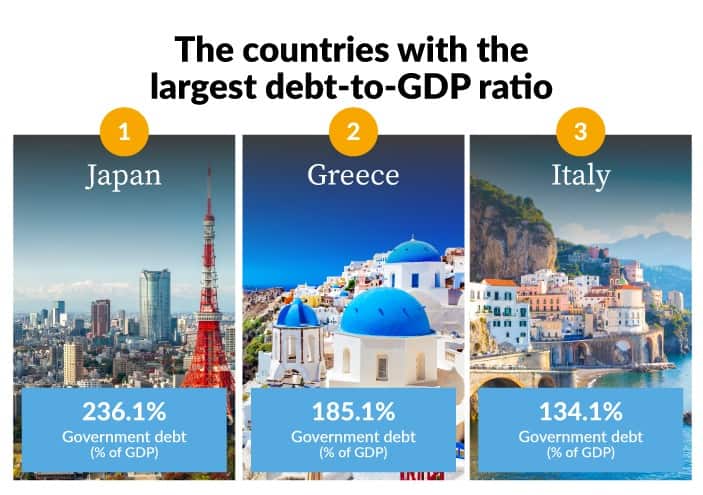Government debt is just part of a country's debt load; companies and households borrow too.

With interest rates and inflation skyrocketing, servicing debt has suddenly become a top concern for investors, public-sector bankers, and central banks. Looking at factors such as government and household finances, which are the most indebted countries? You might be surprised.
External Debt
According to data published by London-based investment fintech Invezz, Japan, Greece, Italy, Portugal, and the US are the top five nations with the highest level of government debt.
Japan’s national debt is a whopping 236% of GDP, the highest percentage of all developed countries, according to Invezz’s research, which is based on OECD data. Japan’s public debt grew rapidly during the coronavirus pandemic driven by a significant increase in emergency spending while its debt-to-GDP ratio grew because GDP growth declined. The Bank of Japan is the buyer of most domestic bonds; these securities allow the government of Japan to access finance at an ultra-low interest rate which experts point to as the main reason why the country has been able to sustain such high debt levels.
With a debt-to-GDP ratio of 185%, most of Greece’s national debt problems appear to stem from the post-2008 global financial crisis (GFC) period, which sparked one of the worst economic collapses since the Great Depression. Greece, alongside countries such as Portugal, Spain and Italy, were most impacted by the fallout from the GFC as they struggled to refinance government debt and bail out struggling banks because they had the biggest debt burdens in Europe before the crisis began.
“Regional factors may be a large part of why Italy’s debts are so high at 134.1%,” states Invezz. Italy was one of the EU countries hit hardest by Covid-19 and–like many governments–stepped up government borrowing during the pandemic to finance emergency spending. According to Fitch Ratings, Italy’s gross general government debt-to-GDP ratio will remain high until 2025, as economic growth is expected to slow faster than falls in the budget deficit.

The United States of America ranks fifth, with its approximate government debt at a staggering $22.7 trillion or 108% of GDP, according to the OECD data used by Invezz. However, June 2022 data published by the US put debt at more than 126% of the country’s nominal GDP, with most of the increased spending due to the Covid-19 pandemic.
The UK—which faces a ‘profound’ economic crisis, according to its new prime minister, in large part because of debts it racked up during the pandemic and higher borrowing costs—had the 10th highest debt-to-GDP ratio, according to Invezz’s research, at 83.9%. If former Prime Minister Liz Truss’s mini-budget, which featured £45 billion of unfunded tax cuts, had been implemented, the UK’s general government debt would have jumped to 109% of GDP by 2024 according to Fitch Ratings, reflecting both higher budget deficits and a weaker growth outlook.
But just focusing on government debt-to-GDP ratios doesn’t tell the whole story, according to Invezz’s research.
Countries With The Most Debt Overall
By aggregating credit-card ownership, household debt as a percentage of disposable income, and the number of Google searches for debt and credit-related terms per 100,000 people into a metric, Invezz created its list of countries with the biggest debt burdens.
With an overall Invezz debt score of 8.42 out of 10, Canada came out as the country on top with the highest debt followed by the UK in second spot with a score of 7.92 and the US in third place with a score of 7.75 out of 10.
“Canada appeared in the top 10 countries for each factor we looked at while also topping the table for credit card ownership,” said Invezz. At 83%, Canada has the highest level of credit-card ownership, ahead of Japan and Switzerland with 69%.
The UK has the most debt-curious population, according to Invezz, with 2,385 Google searches for several debt and credit-related terms per 100,000 people, putting it ahead of the US with 1,446 searches per 100,000 and Australia with 1,166 searches. It also made the top 10 for government debt and for credit-card ownership, for which it placed seventh.
The US placed in the top 10 for debt and credit-related searches, national debt, and credit-card ownership.
Norway is the country with the highest level of household debt based on OECD data followed by Denmark and the Netherlands. With household debt at more than 246% of net disposable income in Norway, people owe almost two and a half times the amount of money they have available for general household expenditures, Invezz’s research revealed. Denmark is not far behind Norway, with household debt as a percentage of net disposable income at 244%, and the Netherlands at 228%.



